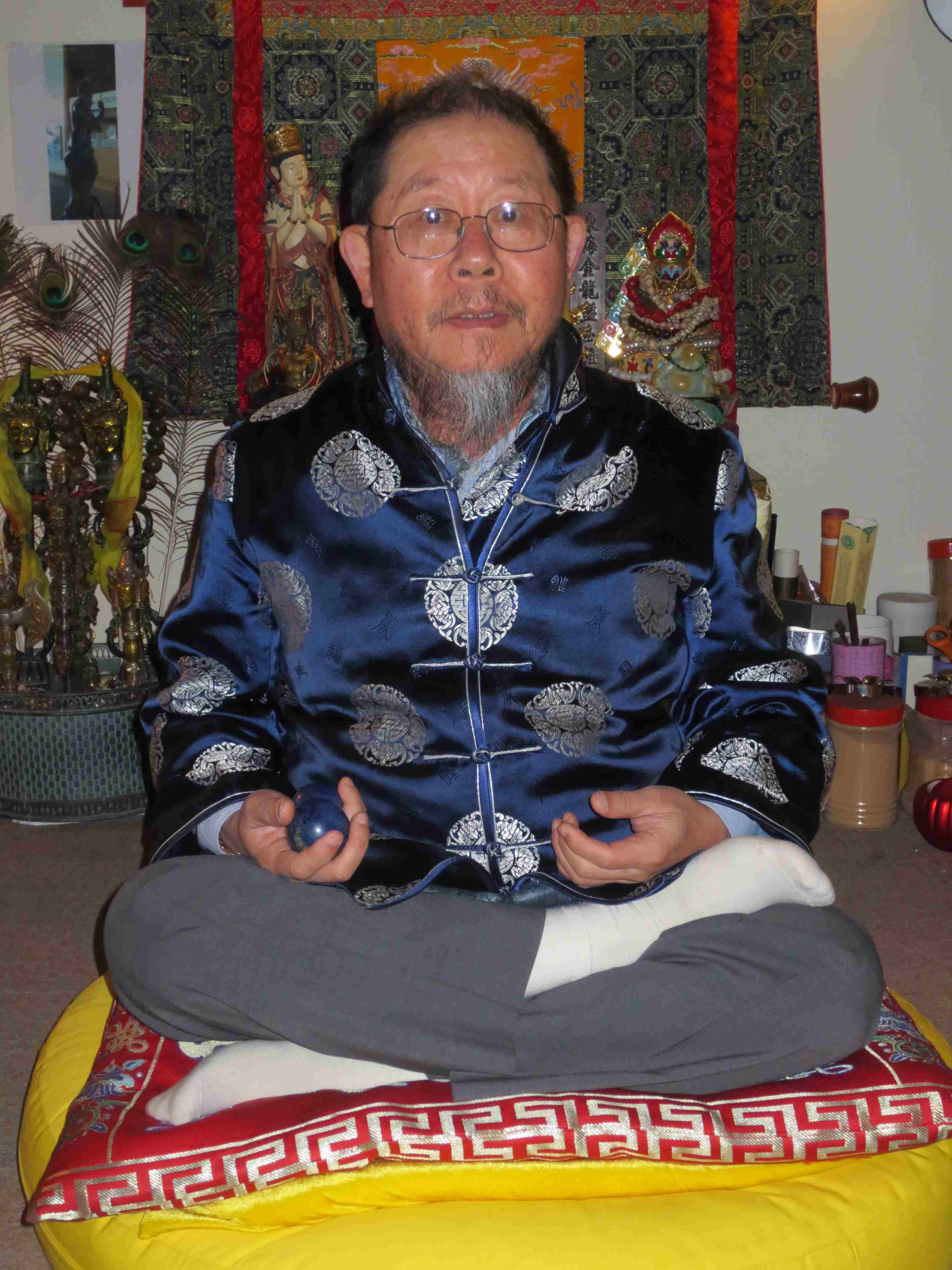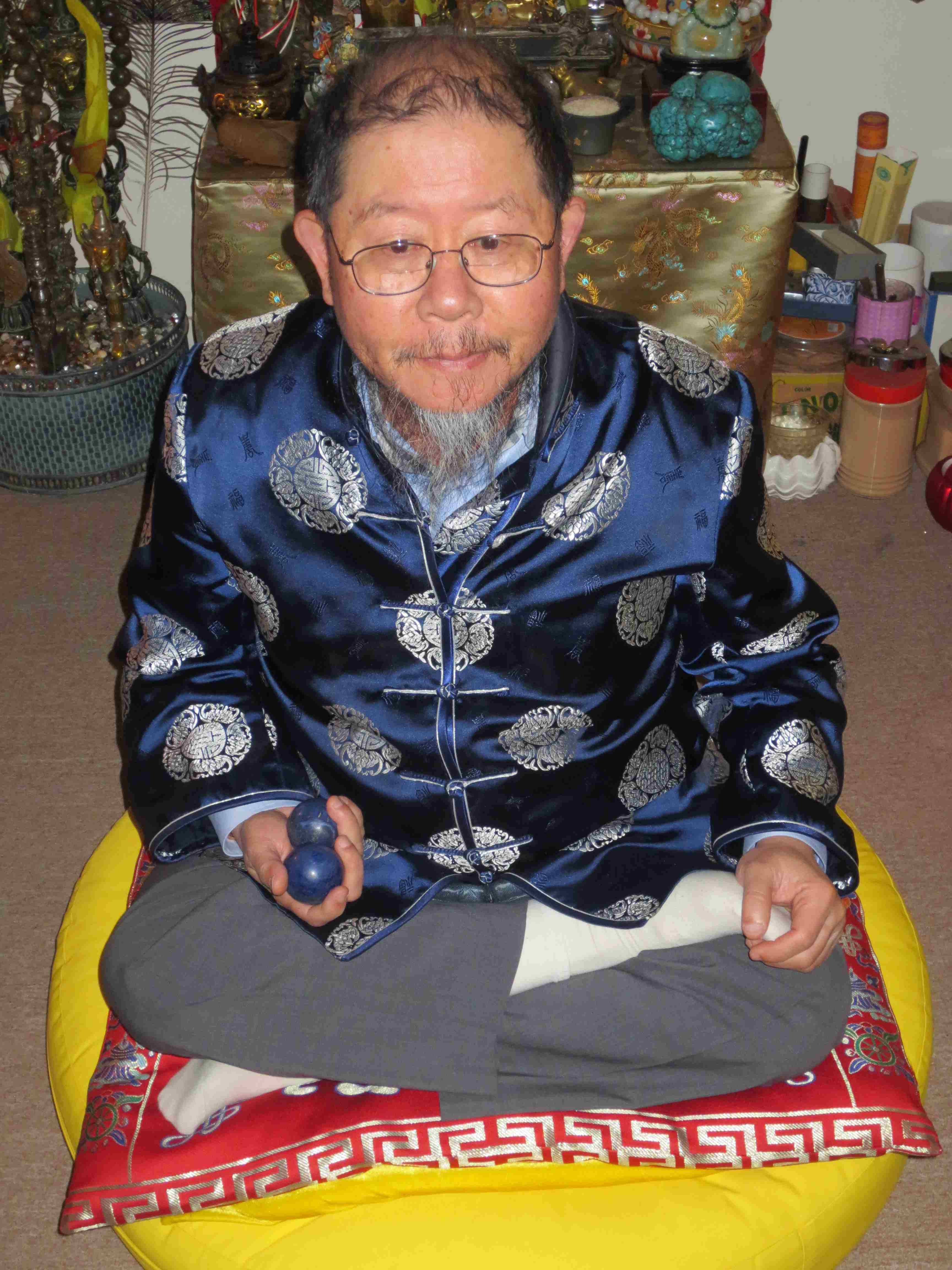Playing with Health Balls
Dr. Yutang Lin
As I walk my son Andrew to and from Harding Elementary School on weekdays, I play in both hands a pair of health balls. This has attracted much attention from many passers-by along the way and parents, teachers and students at Harding. Many have asked me to explain about this exercise or show them how to do it. I was even invited by teachers in room 11 and room 13 to give their students (from kindergartners to second graders) a short talk and demonstration on this exercise. Previously, I wrote an article in Chinese and English on this practice; it was entitled "Chanting with Health Balls." Now that I have had more experiences with this exercise and more related ideas to offer, I am writing this new article based on the old one. Human hands are sensitively connected to the rest of the whole body. Hence, by massaging different parts of the hands, various parts of the body can be stimulated. Feet and ears are similarly related to the whole body. Chinese medicine teaches healing techniques that involve massage or acupuncture applied to these sensitive parts. However, to promote one's general well-being no professional knowledge is needed; all one needs is to adopt some simple exercises on a daily basis. For example, one may adopt the habit of massaging ears whenever one is waiting for a green traffic signal, or one may walk barefoot on pebble paths for fifteen to thirty minutes daily. This article talks about a traditional Chinese hand exercise called health balls.
This exercise originally was taught by a martial art master in the Ming dynasty of China. To this day it has remained a well-know exercise for the promotion of good health. It is a popular exercise in some parts of China, especially in Bao Ding of He Bei province, the place where it originated.
To play with health balls, one holds two balls of equal size and weight in one hand and, using the fingers, rotates them constantly. Depending on the individual, some would find the clockwise rotation natural, while others would find the counterclockwise rotation natural. It seems that there are two types of hands as far as this rotating movement is concerned. First practice rotating in the direction that is natural to you, and later practice rotating in the opposite direction only after you have already become familiar with the natural rotation of balls. A beginner should practice with only one hand at a time, and alternately practice with either hands. Eventually, it is better to practice rotating the balls both clockwise and counterclockwise alternately because they are complementary exercises, and in this way the full potential of the usage of hands will be realized. Through this gentle exercise the fingers become dexterous and the whole body experiences constant waves of soothing massages.
The health balls found in the stores in San Francisco's Chinatown are made of metal, cloisonn?or stone. There are four or five sizes. One needs to choose the size that suits ones hands by trying them out. It is advisable for beginners to start with metal balls because at the beginning it is inevitable that the balls would slip and fall frequently. The metal and cloisonn?balls are hollow with sounding boards inside. Each pair of balls contains sounding boards of different pitches so that the chorus is harmonious. It is said that listening to this sound while rotating the health balls may pacify the mind. For Buddhist practitioners who are interested in practicing the meditation on listening as taught by the great Bodhisattva Avalokitesvara in the Surangama Sutra, this would be a good source of sound to listen to. The stone balls do not come with the sound effects, but it is a blessing when you want to practice in public without disturbing others nearby. Besides, it feels much more comfortable than the metal balls which sometimes would produce static. Cloisonn?balls do not feel comfortable; therefore, I have never practiced with them.
I began my practice with small metal balls because my fingers could not rotate the bigger ones with ease and even then, the small balls would fall through my fingers. After becoming accustomed to rotating one pair of balls at a time, I practiced rotating one pair of balls in each hand simultaneously. It soon became apparent that rotating the balls counterclockwise in the right hand and clockwise in the left hand are easier to do, because in that way, the thumb pushes the balls toward the pinkie. When I tried to rotate the balls in the reverse direction it became very awkward. In fact, I had never used my fingers in that way. Practicing health balls opened up a new horizon for my dexterity.
After using the small health balls for a few days, I could hardly feel their presence in my hands. I then switched to the larger balls and felt comfortable with them. While practicing the health balls, I become more aware of the areas on my hands that are tense or sore and, gradually, also other parts of my body that are not at ease. Doing this exercise does help release tension. Whenever I become tired of reading or writing, I walk around and play the health balls. In this way, my body soon returns to a relaxed and supple condition. Sometimes I walk barefoot on pebbles in my yard while simultaneously playing the health balls. (It is so comfortable to walk barefoot on pebbles warmed by the sun.)
Now I have practiced health balls for more than a decade. During this time I gradually became aware that, while rotating the balls in my hands, my lower arms, my upper arms, and then even the back and front of my torso are also involved in very subtle ways. After months of practice, I first became aware of the involvement of my lower arms because they were no longer as stiff as before. Then, gradually I sensed the upper arms are also moving, and much later even the back of my body. Now I sense all the above mentioned parts are involved in the exercise, especially the whole arms. When I play the health balls I feel the balls are soft and the fingers move so smoothly that it would seem automatic.
Playing health balls would be an ideal exercise for people of all ages because it is gentle, and helps improve one's dexterity and circulation of blood and inner air (Qi). It is an exercise that one can do almost anywhere, without clumsy and expensive equipment. Health balls are suitable especially for the old or disabled. This exercise can promote the circulation of blood and inner air; consequently, it could prevent arthritis. It keeps one alert, and hence is a good preventive measure for Alzheimer. It is known to have helped calm down children with hyperactivity. It is well known that occupational stress and the lack of ergonomic awareness have caused many serious health problems. The practice of health balls may turn out to be an effective and economic solution to such occupational problems.
After months of practice I can rotate simultaneously one pair of health balls in each hand in any direction I want; both clockwise, both counterclockwise, or one clockwise and the other counterclockwise. Experienced practitioners can even play with three or four balls in each hand simultaneously. In fact, one can even combine this exercise with activities such as Tai Ji Quan (Tai Chi) or dances, etc. I have also combined this exercise with walking backwards. Walking backwards helps me to develop some muscles that I have seldom used, and the need to look backwards provides an opportunity to turn my neck to the right rear and left rear alternately as an exercise. I carry a pair of health balls with me on long trips to help adjust my physical condition. To all kinds of people I spread the message of the benefits of this exercise, and I bought health balls for members of my family.
Any physical exercise should be free from mental distractions to be beneficial. With concentration all activities are neatly accomplished. While practicing the health balls it would help induce harmony of body and mind by chanting the name of a Buddha or a mantra. Christians may chant a short prayer such as the prayer of Jesus: Lord, Jesus, son of God, have mercy on me, a sinner. Buddhist practitioners, who are well versed in the chanting practice and are determined to continue their chanting practice until their rebirth in Buddha's Pureland, may use health balls instead of prayer beads and do without the counting of numbers of repetitions. As physical exercise the rotation of health balls is more beneficial than the monotonous movement of prayer beads by the thumb.
While the health balls are rotating, the rotation is constant and yet the positions are impermanent. This observation serves well to illustrate the significance of a fundamental Buddhist teaching that one should not be confined by either side of the dualistic views. The reality as such cannot be encompassed by one-sided views; we had better not be limited by our own prejudices and lose touch of reality.
May all who come across this article become interested in this practice and benefit from adopting this practice. If health balls are not readily available in your surroundings, you can still begin the practice with any round object such as two large marbles or walnuts.
March 31, 1999
El Cerrito, California
Photos:(2014-05-21 added)


My Bodhicitta Vows
(Used for Dedication of Merits)
Dr. Yutang Lin
1. May virtuous gurus remain with us and those departed return soon!
2. May perverse views and violence soon become extinct and Dharma spread without hindrance!
3. May all beings proceed diligently on the path and achieve Buddhahood before death!
4. May all beings develop Great Compassion and never regress until they reach perfect Buddhahood!
5. May all beings develop Great Wisdom and never regress until they reach perfect Buddhahood!
Acknowledgement
Thanks to Upasaka Kwok Sing Hung for formatting the computer file.
Thanks to all Buddhists who helped the publication of this booklet..
Playing with Health Balls
NOT FOR SALE
Donation toward printing and free distribution is welcome.
Edited and Published by Dr. Yutang Lin
Reprinted, September 2002@
5,000 copies
Printed in Taiwan
All rights reserved by Dr. Yutang Lin.
Reprint or redistribute only with permission from Dr. Yutang Lin
For your free copy
Please write to:
Dr. Yutang Lin
705 Midcrest Way
El Cerrito, CA 94530-3310
U.S.A.
[Home][Back to list][Back to Chinese versions][Related Works: Black Sandalwood Balls]